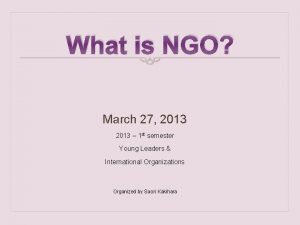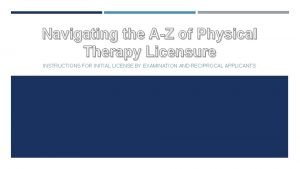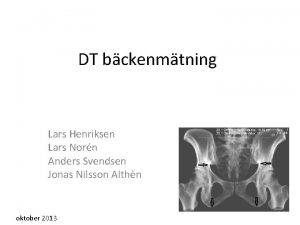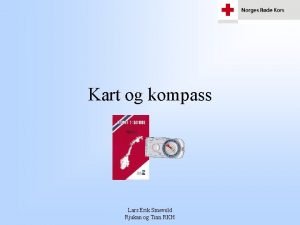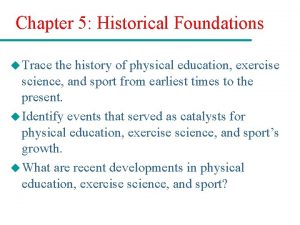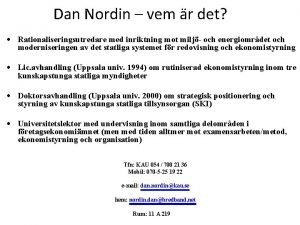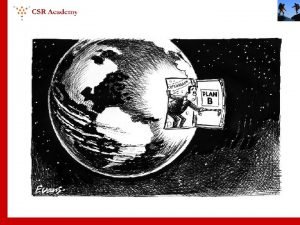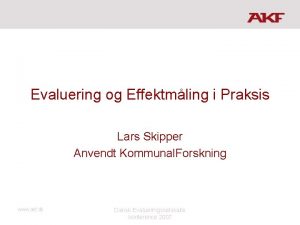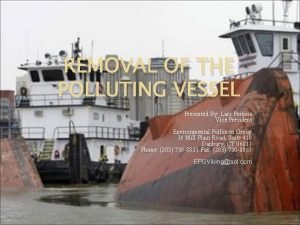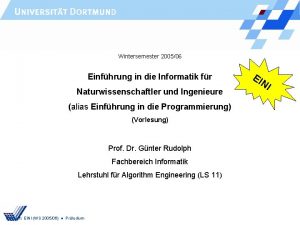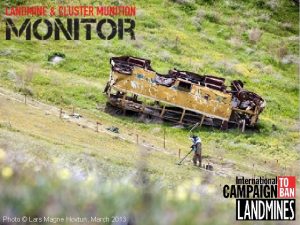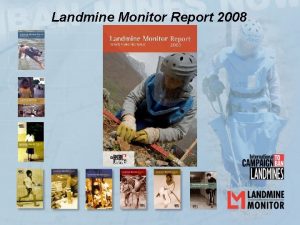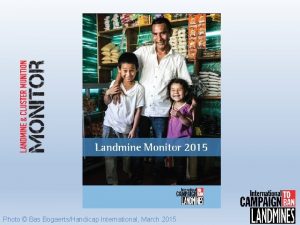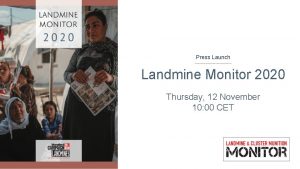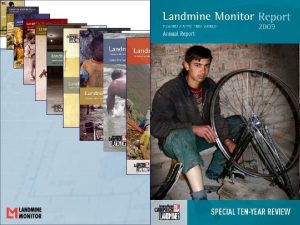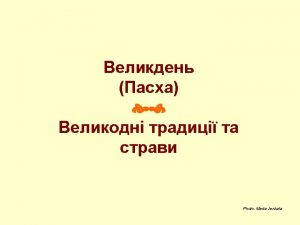Photo Lars Magne Hovtun March 2013 Landmine Monitor


























- Slides: 26

Photo © Lars Magne Hovtun, March 2013

Landmine Monitor 2013 (Presentations, November - December 2013) Overview New records in 2012 • • • Lowest annual new casualties Largest amount landmine-contaminated land cleared Highest level of global funding for mine action Antipersonnel mine use • Use confirmed by State Party – Yemen • All use must be urgently addressed, including by states not party and non-state armed groups

Landmine Monitor 2013 Main sections: • • Landmine Ban Policy Mine Action Casualties and Victim Assistance Funding Support

The Mine Ban Treaty Photo © Nora Sheets, October 2013 There are 161 States Parties and one signatory to the Mine Ban Treaty.

Mine Ban Treaty status

Landmine use • Antipersonnel landmines were laid in large numbers, apparently by government forces, in Yemen at two locations in 2011: Bani Jarmooz and the Ministry of Trade and Industry compound in the capital, Sana’a. • Lingering and new allegations of antipersonnel mine use in States Parties South Sudan, and Turkey warrant further investigation. • Government forces in Myanmar and Syria used antipersonnel mines in 2012 and 2013. Both states remain outside the Mine Ban Treaty. • Forces in the internationally unrecognized breakaway area of Nagorno-Karabakh emplaced new antipersonnel mines in 2013.

Landmine use by non-state armed groups • Non-state armed groups used antipersonnel mines or victimactivated improvised explosive devices in Afghanistan, Colombia, Myanmar, Pakistan, Syria, Thailand, Tunisia, and Yemen. • With the addition of Syria and Tunisia, the number of countries where non-state armed groups have used mines has reached its highest level in five years.

Production of landmines China Myanmar Singapore Cuba North Korea South Korea India Pakistan United States Iran Russia Vietnam • Down from a total of more than 50 states before the Mine Ban Treaty’s existence, currently only 12 states are identified as potential producers of antipersonnel mines.

Stockpile destruction Photo © HALO Trust, July 2012

Stockpile destruction (continued) • Collectively, 87 States Parties of the Mine Ban Treaty have destroyed more than 47 million stockpiled antipersonnel mines, including more than 250, 000 destroyed in 2012. • Nearly 11 million antipersonnel mines await destruction by eight States Parties. • Belarus, Greece, and Ukraine remain in violation of the treaty after having failed to complete the destruction of their stockpiles by their four-year deadline. Belarus and Greece had a deadline of 1 March 2008, while Ukraine had a deadline of 1 June 2010.

Landmine transfers • For the past decade, the global trade in antipersonnel mines has consisted of a low-level of illicit and unacknowledged transfers, but the abrupt appearance of mines in Sudan and Yemen indicates that some form of market for, and trade in, antipersonnel mines exists.

Contamination

Clearance of landmines

Clearance of landmines (continued) • A record high of at least 281 km 2 of mined areas were released through clearance or survey by 40 mine action programs in 2012— up from at least 190 km 2 in 2011—destroying almost 240, 000 antipersonnel mines and 9, 300 antivehicle mines. • The largest total clearance of mined areas in 2012 was achieved in Afghanistan, Cambodia, Croatia, and Sri Lanka, which together accounted for 62% of recorded clearance.

Clearance of Landmines (continued) • Over the past decade, almost 1, 981 km 2 has been released through clearance or survey; more than 3. 3 million mines were removed from the ground. • In addition, some 245 km 2 of battle areas were cleared in 2012, including 78 km 2 of area contaminated by cluster munitions, and destroying just over 300, 000 items of unexploded ordnance. • In 2012, five States Parties formally declared fulfillment of their Article 5 obligations to clear all known mined areas: Republic of Congo, Denmark, Gambia, Jordan, and Uganda.

Casualties

Casualties (continued) • A global total of 3, 628 casualties were recorded in 2012, a 19% decline compared with 4, 474 in 2011. • Recorded casualties caused by mines, victim-activated improvised explosive devices, cluster munition remnants, and other explosive remnants of war decreased to the lowest level since the Monitor started recording casualties in 1999. • The incidence rate of 10 casualties per day for 2012 is a 60% decrease from what was reported for 1999, when there were approximately 25 casualties each day.

Casualties (continued) • Casualties were identified in 62 states and other areas in 2012, of which 42 are States Parties to the Mine Ban Treaty. • The vast majority of recorded landmine/ERW casualties were civilians; the proportion of civilian casualties as compared with military casualties increased to 78% in 2012, five percentage points higher than in 2011. • In 2012, child casualties increased as a proportion of civilian casualties (to 47%, four percentage points higher than in 2011); and female casualties increased as a proportion of all casualties (to 13%, three percentage points higher than in 2011). • Seventy percent of recorded global casualties occurred in States Parties.

Victim assistance Photo © Till Mayer/Handicap International March 2012

Progress in victim assistance • Since 2009 significant progress has been made in Victim Assistance: Ø Improving the understanding of mine/ERW victims’ needs. Ø Coordinating and planning measures to better address those needs. Ø Linking victim assistance coordination with multisectoral coordination mechanisms, such as those for disability and development. Ø Informing mine/ERW victims about existing programs and services and, in some cases, facilitating their access to available services. Ø Strengthening legal frameworks to promote the rights of victims, including by advancing the right to physical accessibility for persons with disabilities.

Remaining Challenges to victim assistance • Increasing the availability and sustainability of relevant programs and services, especially to survivors in remote areas; • Ensuring that all mine/ERW victims have access to programs that meet their specific needs, particularly in employment and livelihoods as well as psychological support; and • Ensuring that all victims, along with other people with similar needs, have equal access to age and gender appropriate services.

Funding and Support • Donors and affected states contributed approximately US$681 million in international and national support for mine action in 2012. • This was the largest combined total ever recorded and $19 million more than in 2011. • International assistance in 2012 was a record $497 million, an increase of $30 million as compared with 2011. © HALO Trust, August 2013

Funding and Support (continued) • A total of 52 states and four other areas received $439 million from 39 donors in 2012. A further $58 million was provided without a designated recipient state or other area. Seven states and the EU contributed 80% of this funding. • Afghanistan received more funding than any other country for the tenth consecutive year. The largest increases among recipients were in Mali, Myanmar, and Somalia, with $41. 2 million combined in 2012 compared with $4. 7 million in 2011. • Of the six new recipients in 2012, Mali received the most support with $7. 7 million. The other five new recipients—the Philippines, Syria, India, Senegal, and Zimbabwe—received a total of $9. 2 million.

National and UN funding • Twenty-eight affected states provided $184 million in national support for their own mine action programs, a decrease of $11 million compared with 2011. • In addition, appropriations from the UN General Assembly for mine action within nine peacekeeping operations provided more than $113 million in 2012—a 25% increase compared with 2011.

Additional resources • Country profiles • Factsheets, Maps, Tables • Landmine and Cluster Munition Blog landmineandclustermunitionblog. wordpress. com • ICBL website www. icbl. org

Thank you! Visit us: www. the-monitor. org monitor@icblcmc. org @Mine. Monitor @minefreeworld Photo © Ngo Xuan Hien/Project RENEW, August 2012
 What is a butterfly mine
What is a butterfly mine Poland national anthem lyrics
Poland national anthem lyrics Writing to learn
Writing to learn What is ngo
What is ngo Patellarsenegraft
Patellarsenegraft Magne bakken
Magne bakken Magne tveit
Magne tveit Magne kolstad
Magne kolstad Christian waschke
Christian waschke Lars tn gov
Lars tn gov Uhthoffs fenomen
Uhthoffs fenomen Legamento lars terza generazione
Legamento lars terza generazione Lars henriksen
Lars henriksen Vanessa bouchet
Vanessa bouchet Redon drainage bilder
Redon drainage bilder Lars erik smevold
Lars erik smevold Bettina gereth
Bettina gereth Lars gabriel branting contribution in physical education
Lars gabriel branting contribution in physical education Dan nordin
Dan nordin Lars bildsten
Lars bildsten Lars moratis
Lars moratis Lars skipper
Lars skipper Lars lyberg statistics sweden
Lars lyberg statistics sweden Lars perkins
Lars perkins Lars duvaland
Lars duvaland Lars skala
Lars skala Lars littig
Lars littig



